As dawn broke slowly over the Maui Channel, Doug Borland and I faced a dilemma. Cooped up by torrential rain for the previous two days, we really needed to get into the hills and go hunting. The weather was beautiful now, but the downpour had left the ranch road we planned to travel impassable. Even under the best of conditions, the road only took us halfway to the mountaintop we planned to hunt, but that was still two fewer hours of steep climbing. Now, with the rig pulled off the road at sea level, the mountain loomed even higher than usual, but we were young and dumb, and we had come to hunt.
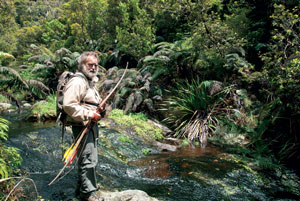
Flowing water in the Hawaiian highlands. It may look good, but it is usually contaminated by animal droppings.
By noon, we were sitting on an open ridge between two shear canyon walls talking strategy. My biggest concern was our water supply. You burn a lot of it hiking uphill in tropical heat, and I’d already downed half my supply. There’s plenty of water in the Hawaiian “cloud forest” high above the sea, but most of the surface supply has been wallowed in (and worse) by wild pigs. I had consumed surface water there before out of desperation, but I didn’t look forward to doing so again.
Doug and I decided to split up, hunt, and meet back at the same spot in two hours to reassess our reserves. While he headed off toward the next canyon, I began still hunting along a tight jungle trail where I’d shot a pig the previous year. Returning an hour later with a full quiver, I decided to conserve water by sitting down and glassing the open terrain along the edge of the cliffs. That’s when I saw the goats.
I actually heard them before I saw them, and it was the sound of their incessant bleating that drew my attention back up the ridge behind me. While I’d been back in the jungle, a herd of a dozen goats had emerged from their security habitat in the cliffs to browse on the ridge’s open terrain. The herd consisted of kids, nannies, and young billies, but I honestly didn’t care about the absence of big horns. We were supposed to be providing some food for a party with local Hawaiian friends the following night and didn’t want to insult them with store-bought chicken. Meat from younger goats—cabrito—is far superior to that from old billies on the table.
After checking the wind, which couldn’t have been better, I decided to give the goats some time. My first priority was to let them feed as far from the cliff rim as possible, since I knew that a wounded goat that bailed over the edge would present a difficult and dangerous recovery problem. A close friend on the island had lost—lost, as in dead—a hunting partner to a fall from these same cliffs the year before, and the incident remained fresh in my mind. While I watched, I tried to narrow my focus down to one goat. It didn’t matter biologically—there were no seasons or limits, and all the goats were destroying the island plant life equally. I did notice one young billy with a particularly attractive black and silver coat and decided to take that one if given the chance.
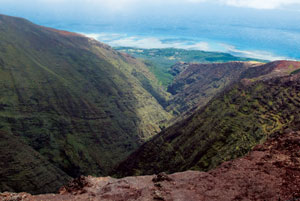
Hawaiian goat habitat: Not for the faint of heart.
Finally, I started to move. My only cover was terrain on the lip of the cliff, so I proceeded slowly and carefully out of necessity. When I drew even with the goats they were still out of range, and with nothing but short grass between us my only option was to wait. Luck seldom gets the credit it deserves on successful stalks, but the goats eventually did what I needed them to do and started slowly back in my direction. Even better, the billy I’d picked out was in the lead. Soon he stood thirty yards away. That’s maximum range for me, but I might have taken the shot had he offered me a broadside, which he didn’t. This led to more waiting—another underrated component of most stalks that end well for the hunter.
He had narrowed the gap between us by a half-dozen paces by the time he turned and exposed his ribs. It’s funny how some instinct tells you when you’ve made a perfect shot before you even let the string slip from your fingers. The arrow flew true and struck the billy tight behind the shoulder.
All I could do as the ridge top exploded with running goats was hope the one I’d shot didn’t make it to the cliff.
* * *
Humans and goats have enjoyed a long, complex history together. The wild goat genus of caprids is native to Eurasia and includes the markhor and multiple species of ibex. (The more familiar mountain goat that appears in this magazine’s logo originated in the New World and is only a distant relative.) Capra aegagrus, which gave rise to the domestic goat subspecies, likely descended from the bezoar ibex, a native of the Middle East. Human hunters have been pursuing goats since the dawn of recorded history. Ibex appear in cave paintings of hunting scenes dating back to the Paleolithic Age, and Homer provides vivid descriptions of Greek hunters pursuing goats with bows and arrows in the Odyssey.
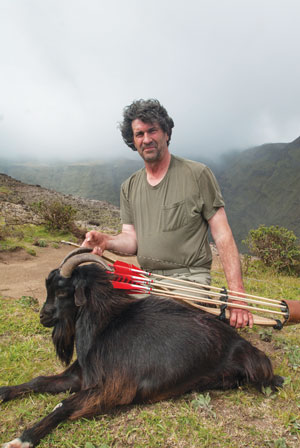
Renowned bowyer Dick Robertson with a Hawaiian goat.
Goats have been important icons in human culture for just as long. The lusty satyrs and fauns of Greek mythology were half man and half goat. The Norse god Thor was said to drive a chariot pulled by goats. The goat is one of the twelve characters in both the traditional Chinese calendar and the western zodiac, where it appears as the constellation Capricorn. The Tropic of Capricorn is the name for the line of latitude defining the southernmost point at which the sun appears directly overhead on the December solstice.
Goats were one of the first large mammals to be domesticated, probably around 10,000 years ago. Because of their hardiness, durability, and ability to adapt to a wide range of habitats, humans soon introduced them widely throughout the world. A 2011 United Nations Food and Agriculture survey estimated a global population of over 900 million goats. Today, chevron, the formal name for goat flesh, is the most widely consumed meat in the world.
Much like hogs, domestic goats need little encouragement to escape confinement and revert to their wild state. There were no hooved mammals native to Australia or New Zealand, and homesick colonists from the British Isles began to introduce both game and domestic species soon after their arrival. Pigs and goats quickly established large feral populations in both places. As European sailors began to explore the vast Pacific they found no food animals on most of the islands they discovered, save for pigs introduced by Polynesian seafarers. The British released pigs and goats on many of those islands, to give future shipwreck victims a better chance of survival.
Nature evidently abhorred a vacuum here in America as well—at least in the eyes of some well-intended but ultimately misguided humans. California’s Channel Islands offered a case in point. After expelling the island’s Native American population, Spanish settlers introduced a number of domestic animals including pigs and goats, which rapidly established large feral populations that would eventually add an interesting footnote to the history of America’s modern bowhunting revival. Many well-known bowhunters spent time hunting feral goats there. Today, the Channel Islands’ goat population has largely been eliminated in an effort to preserve native habitat.
Introduced feral goat populations provided meat, milk, hides, and hunting opportunities for colonists and indigenous people alike, but these benefits came at a cost. Isolated island ecosystems are the Earth’s most fragile. Cut off from the rest of the world for millennia, native island flora and fauna developed without having to deal with browsers, predators, or more successful competitive species. All too often, the sudden introductions of new plants and animals proved disastrous, especially in the case of large mammals. Absent natural predators, feral goat populations exploded across the Pacific.
Despite the amount of time I’ve spent in Australia, which likely has more feral goats than any other country in the world, I’ve never hunted them there. The heart of Australian goat country lies in the vast, arid interior, where “Outback” is more than an American steakhouse chain. Despite hunting extensively along Australia’s coast, I’ve never made it to the interior. New Zealand is another matter.
On one South Island hunt the tahr I was after proved elusive, but I saw feral goats frequently. After one more failed effort with the tahr, I decided to stalk one. The terrain held plenty of up and down, but it wasn’t nearly as treacherous as the goat habitat I knew in Hawaii. The stalk went smoothly and the goat—another young billy—dropped in plain sight. The following day, I killed another one. Our hosts weren’t enthusiastic about eating goats and Lori and I weren’t set up to do our own cooking, so all I was doing was eliminating an unwanted threat to the local environment. Doing that twice was enough for me.
Before chiding me for not eating what I shot —and yeah, I admit feeling badly about that—bear in mind that the New Zealand government was engaged in an active goat eradication program using poison and aerial gunning. Similar measures have virtually eliminated the goat population from some areas where I used to hunt them in Hawaii. That sounds harsh, but the environmental destruction a robust feral goat population can inflict is incredible. During a period of drought in Hawaii, I watched goats climbing twenty feet up trees to devour leaves and twigs after they’d consumed all the forage at ground level. As much as I’ve enjoyed goats as a bowhunting quarry, many parts of the world are better off without them, especially the Pacific’s isolated islands.
* * *
Back on that Hawaiian mountaintop, I watched anxiously as the goats dashed for the security of the cliffs. I knew full well what I’d face if the one I shot made it over the edge. The only time I have ever abandoned the recovery of an animal I knew I’d hit and killed involved a similar situation on a ridge nearby the previous year, when I made a solid hit on a goat that did make it down into the cliffs. In addition to having nearly vertical faces, those cliffs consist of loose, crumbly rock that can collapse underfoot at any time. As we peered over the rim that day, Lori told me that no goat was worth my life, and for once I listened to her.
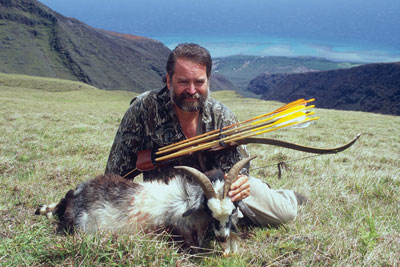
The Hawaiian goat described in this story. This is the only known field photo of Don Thomas with neat hair. The sweat did it.
I was more fortunate this time. The goat I’d hit soon began to lag behind his companions, and then it faltered and collapsed. I’d barely had time to dig my knife out of my pack when Doug appeared. “Did the wild dogs kill it?” he asked.
Granted, we’d seen a pair of feral dogs hunting halfway up the mountain that morning, but come on. “No, you idiot!” I replied testily. “I killed it!” Then we shared a laugh and a precious bottle of water and began cutting up the goat.
I had a point to make. Back when I was living in Alaska, a friend used to make an annual trip to his family ranch in Texas, and he’d always return with a cooler full of feral goat meat. Cooked in the traditional Mexican cabrito style, I found it delicious. Our Hawaiian friends, however, did not share that opinion. While feral hog enjoys a nearly religious stature in island cuisine, none of our friends ate goat. When I pressed them on the subject, most admitted that they’d never tried it.
A lot of that aversion—which I encountered in New Zealand too—stems from goats’ distinctive, powerful odor. In Australia, wild goats are called “stinkies” for a reason. However, the oils that produce that smell reside in the hair and hide, not the meat. The trick is to keep your hands away from the skin while butchering the animal, a goal best accomplished by having a hunting partner tug on the hide while you cut up the meat with clean hands. With that mission accomplished, Doug and I set out on the long downhill trek back to sea level, our packs pleasantly heavier with fresh goat meat.
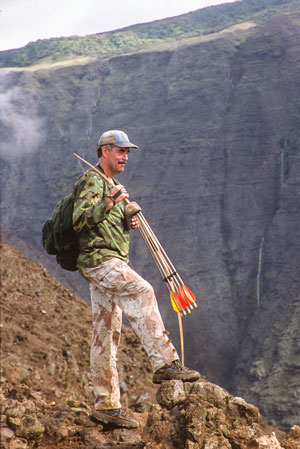
Doug Borland, with the location of Don’s goat kill in the background. The difficulty of recovering an animal from those cliffs should be obvious.
The following evening, our friends arrived at Doug’s place bearing fresh lobster (they’re all expert free divers and spearfishermen) and a slab of ulua (giant trevally) for sashimi. The seafood made great pupus (appetizers), but I was responsible for the main course. I’d decided to cook the goat in a curry, which I served on a large platter next to a bowl of steaming rice. Whenever someone asked me what was in it, I just mumbled something vague about “wild game.”
It didn’t take long for slurping sounds to replace the conversation. “Man, this is ono!” our friend Walter declared, making my day. Ono is the Hawaiian word for “sweet” or “delicious,” and it’s the highest compliment a cook can receive in the islands. “What kind of meat did you say this is?”
I told him, and after a moment’s hesitation the slurping resumed. Mission accomplished.



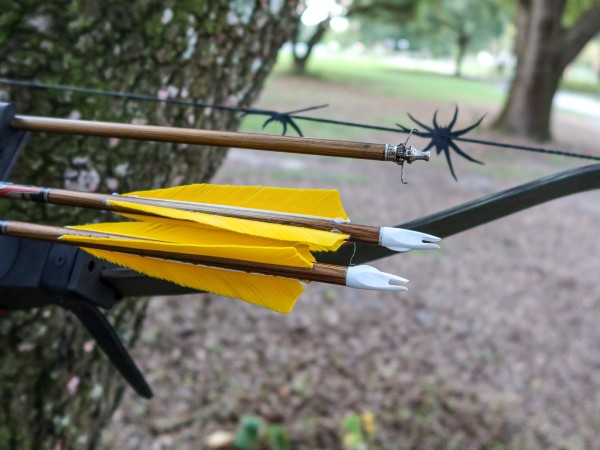


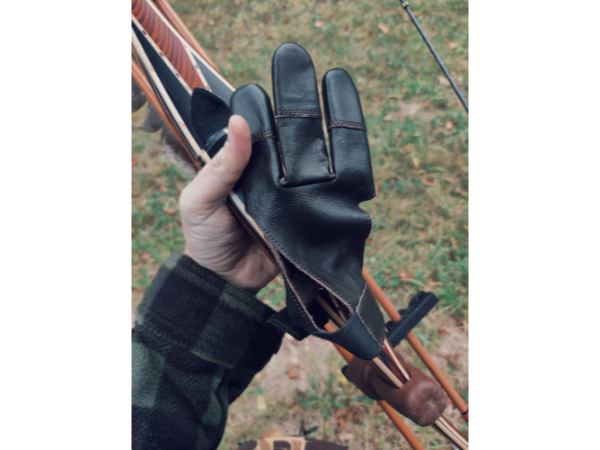
Thanks Don, it was a good read. We are booked into Maui for 2020 and again goats will be drawing my attention. We were last there about 7 years ago and after inquiring if there were any local trad Bowhunters, no one said there were such, I went solo. In a pre-scout afternoon in a suitable area (it wasn’t vertical!) I saw a fellow emerge from the forest cover shade with what looked like a bow in his hand. A recurve! And he was a local who regularily shot wild hogs for his meat supply. Well, after introductions and sharing our common interest he invited me to his hog blind for the following day and from which he would show the way to access the upper slopes of the volcanic mountain. I did get into goats and had a nanny at 12 yds. but elected not to shoot as her kid was with her. The herd had a number of fully horned billy’s but never in range. After seeing how those goats don’t just “trim” the ground cover but destructively tear it up roots and all I regretted my choice now to shoot. Without a winter of white beauty the kid would have done fine in the company of it’s relatives. Needless to say I’m quite excited to have a redemptive return to Maui to try again!
David—I have been traveling up north and apologize for the late reply. The only mammals native to the Hawaiian Islands are the monk seal and the Laysan bat. Everything else is an invasive alien species, and they are destroying the island’s native ecology, none more so than the feral goat. Let those arrows fly! Most Hawaiians don’t like to eat goat )as opposed to pigs, which are a long tradition), but the younger ones are delicious. Don